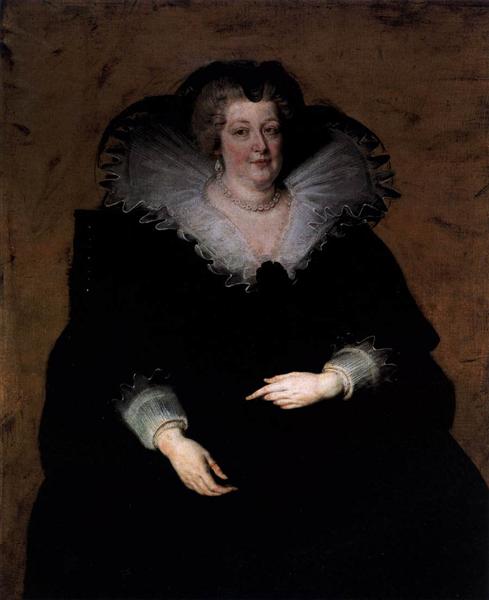Beskrivning
Arbetet "María de Médicis" (1622) av Peter Paul Rubens är en av de mest emblematiska bitarna av barocken, en period som kännetecknas av hans överflöd och drama. Denna målning, som är en del av en serie med 24 målningar som berättar drottning Maria de Médicis liv, ligger i ett sammanhang där Rubens utforskade sammansmältningen av den historiska berättelsen med upphöjningen av monarkisk makt. Detta speciella porträtt, där drottningen förekommer omgiven av en serie av mytologiska allegorier och figurer, framkallar en stark känsla av majestät och teatralitet.
Arbetets sammansättning sticker inte bara ut för att använda rymden, utan också för hur Rubens placerar María de Médicis i mitten av den visuella berättelsen. Drottningen, klädd i en elegant klänning dekorerad med rika motiv, verkar komma fram till myndighet, medan hennes ansikte återspeglar både styrkan och sårbarheten i hennes position. Hans lutning något åt sidan antyder en dynamisk rörelse, en vanlig egenskap i Rubens stil, som ofta innehåller vital energi i hans figurer.
Vibrerande färger är en signatur av konstnären och kan ses under hela arbetet. Rubens använder varma toner för att lyfta fram både drottningens hud och duken som omger den och uppnår en anmärkningsvärd kontrast till den mörkaste bakgrunden som accentuerar huvudpersonernas ljusstyrka. Drapeadas av kläderna ger en tre -dimensionalitetssensation, ett distinkt drag i Rubens talang för att fånga materiens struktur och flytande.
Målningen innehåller också en serie allegoriska figurer som representerar dygder och element i historien, såsom styrka och visdom, som inte bara talar om rollen som Mary of Medicis i historien, utan också om deras koppling till idealet för den illustrerade monarken. Dessa figurer, av vilka några är magnifika muskulösa och nästan övermänskliga, i kontrast till drottningens delikatess, och accentuerar hennes roll som en symbol för makt och kvinnlighet.
En fascinerande men mindre betraktad del av detta arbete är dess plats inom det stora arbetet som ägnas åt María de médicis, vilket återspeglar de politiska oro och det sociala sammanhanget för tillfället. Rubens var inte bara en enastående målare, utan också en diplomat, som gjorde det möjligt för honom att fånga komplexiteten i maktförhållandena i sin tid. I detta avseende uppförs "María de Médicis" som ett visuellt vittnesbörd om monarkisk propaganda, som kombinerar estetisk skönhet med representationen av en central figur i europeisk historia under sjuttonhundratalet.
Rubens arbete är lika anmärkningsvärt för sitt inflytande på utvecklingen av barocken och i våra begrepp om representation av royalty. Dess förmåga att slå samman visuellt språk med känslomässigt innehåll har lämnat ett outplånligt märke inte bara i sitt historiska sammanhang, utan också i generationer av senare konstnärer som försökte efterlikna den förmågan. "María de Médicis" förblir en källa till studier och beundran, ett tydligt exempel på hur konst kan överskrida tiden och fortsätta prata om kraft, historia och identitet genom linsen av skönhet och teknik.
KUADROS ©, en berömd färg på din vägg.
Handgjorda oljemålningar, med kvaliteten på professionella konstnärer och den distinkta tätningen av KUADROS ©.
Bilder reproduktionstjänst med tillfredsställelsesgaranti. Om du inte är helt nöjd med kopian av din målning, återbetalar vi dina pengar 100%.

